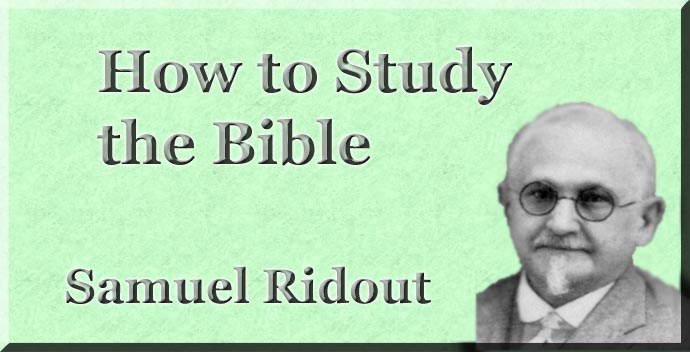
How to Study the Bible
By Samuel Ridout
Chapter 18
Part 5. Helpful Books for Bible StudyConcordancesWe will speak of concordances first as being practically indispensable to those who are going to make progress in study. There are numbers of these, and it will not be understood that we are recommending one to the exclusion of others if we do not mention all. In selecting a concordance one should know exactly what he desires, as it is well nigh impossible to get every feature in one book. Of first importance for ordinary Bible students is one which gives every word in the Bible in alphabetic order with a reference to every passage in which it occurs, and a sufficient number of words to enable one to identify the reference. Of books which practically do this, perhaps the earliest was "Cruden's Concordance," which in its various editions still remains the one most commonly in use, with many excellent features to recommend it. It is not, however, strictly alphabetic, but the same word is sometimes divided into groups with characterizing words, so that two, three or more lists or groups of the same word are given, which are somewhat confusing to one merely looking for a passage. "Walker's Concordance" is quite good, although possibly not so complete as Cruden's, but without the undesirable feature we have just mentioned. "The Oxford Pocket Concordance" is a much smaller book, suitable for carrying about, but would scarcely be recommended for permanent use, being so much abridged. The best of all verbal concordances with which we are acquainted is Strong's "Comprehensive Bible Concordance," which has the advantage of placing every English word used in the Scriptures, including all proper names, in exact alphabetic order. This excludes the articles "a" and "the" and a few pronouns and other particles constantly in use. The author, however, has even included these in an appendix, indicating an immense amount of labor for which, with all respect to his diligence, we do not see the need. With this concordance, the English reader can select any word, except those just mentioned, and find its reference in the concordance. He will not be confused by a variety of lists, groupings, divisions or anything else. In addition to this, each word has a number, while different kinds of type indicate whether the word is Hebrew or Greek. These numbers are arranged in their order in two other appendices, in which the original Greek or Hebrew word is given, spelled also in English letters, with its meaning, and with the various English words which are used to translate it in our Bibles. We are thus quite completely in touch with the original tongues. Perhaps it is the best of all concordances for those who can have but one. Its great bulk, however, makes it unwieldy — a hindrance for some. "Young's Analytical Concordance" differs in some respects from Strong's. It gives us the English words in their alphabetic order, and under each English word we have the various original words which are used to translate it. Here we have lost the thought of a reference concordance, but have gained greater accuracy in having the different original words which are translated by the one English word classified in separate lists under an English heading. "Young's Concordance" gives us, no doubt with a good degree of accuracy, all the original words translated by one English word. He fails, however — which seems a distinct blemish — to give us all the original words, whether translated by different English ones or not. In other words, he has made the English version the basis, instead of the original. We come next to "The Englishman's Hebrew and Chaldee Concordance" and "The Englishman's Greek Concordance" by G. V. Wigram, which we consider the most helpful and scholarly work of its kind. Here, the original is made the basis and the words are arranged in the order of the original alphabet and not of the English. Under each original word is given in English every occurrence of that word in Scripture, after the manner of "Strong's" or "Cruden's." The English word which is the translation of the original is printed in italics, so that there can be no doubt. Thus, the ordinary English reader is put in possession of a concordance to the original tongues, but on an English basis. The Hebrew and Greek are given in their own characters, and spelled out in English also. All in all, for purposes of study, we consider "Wigram's Concordances," especially the Greek one, to be the most useful of all. However, as we have already said, Strong's is the best where only a single concordance can be had. Our recommendation would be Strong's and Wigram's. We merely speak of other works, no doubt excellent in their way: "Hitchcock's Bible Analysis," Bullinger's and Hudson's Concordances, and a very portable one for a Greek scholar, Schmidt's. All are useful in their place. In addition to a concordance, we would recommend "The New Topical Text Book" with an introduction by Dr. Torrey, in which various Scripture passages are grouped together to illustrate certain topics, This little book will be found quite helpful in the topical study of the Bible as described in Part 1, Section 5. Simply for those who may desire to know, we mention for the Old Testament, Tregelles' Edition of "Gesenius' Hebrew Lexicon" and for the Greek, perhaps none is better than Dr. Robinson's Dictionary of New Testament Greek. Cremer's might also be named. |
|
 |
 |
|
|
|
-
Site Navigation
 Home
Home What's New
What's New Bible
Bible Photos
Photos Hiking
Hiking E-Books
E-Books Genealogy
Genealogy Profile
Free Plug-ins You May Need
Profile
Free Plug-ins You May Need
 Get
Java
Get
Java.png) Get Flash
Get Flash Get
7-Zip
Get
7-Zip Get Acrobat Reader
Get Acrobat Reader Get
TheWORD
Get
TheWORD